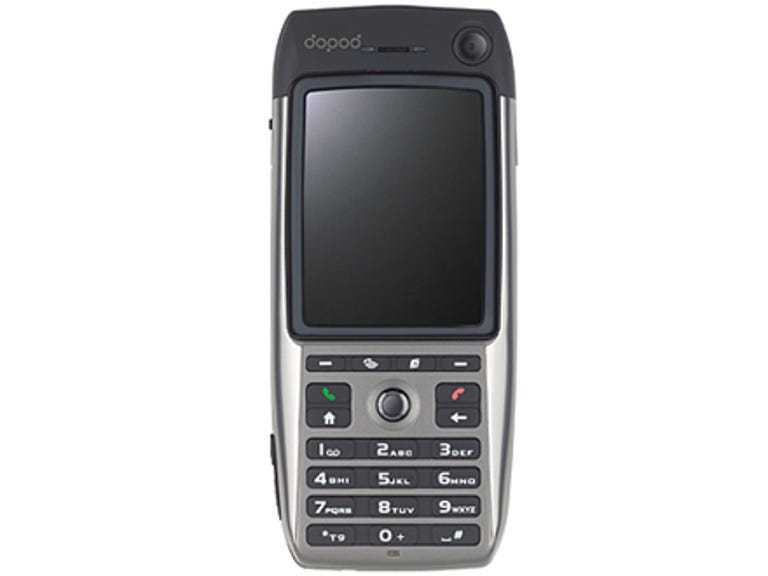 Why You Can Trust CNET
Why You Can Trust CNET Dopod 595 review: Dopod 595
Dopod's 595 lacks some of the features of its larger smartphone cousins, but should hold its own against competing mini PDA phones.
Although you've probably never heard of Dopod we can guarantee you've seen, and maybe even owned, products designed and produced by its parent company HTC. That's because the Taiwanese-based HTC is responsible for an estimated 80% of the world's Windows Mobile smartphones and PDAs. These include models from HP, i-mate and O2 plus overseas players such as Orange, T-Mobile and Cingular. Dopod is a subsidiary of HTC, and has recently joined the company's Qtek as one of HTC's two house brands. Touted as the world's first 3G smartphone running Windows Mobile 5, the 595 joins the 838Pro as Dopod's first products in the Australian market.
The Good
The Bad
The Bottom Line
Design
The 595 sports a distinctly uncluttered European look which stands in stark contrast to its busier smartphone siblings in any of the popular 'candybar', PDA or sliding keyboard forms. It's tall, slim and stylish in an understated way.
That first impression is underscored by the gently tapered gunmetal-coloured chassis and its darker rubberised fairings and keypad. In fact, the 595 seems much more like a regular mobile than a smartphone. The alphabet overlay on the keys uses a standard ABC layout rather than QWERTY, while the 1.3-megapixel camera and large 2.2-inch (5.6cm) screen are a common sight on multimedia-enhanced 3G phones. Only a single button wearing the stylised 'e' of the Internet Explorer logo gives any hint that there's more to the 595 than just talking and texting.
The keyboard is somewhat cramped by the phone's compact shape but the keys are easy to use, although the backlighting created by blue lights at each side favours the outermost columns of keys while leaving the middle with a dim underglow. Navigating around the screen and menus is effortlessly achieved with the rubber-tipped four-way controller, the rocker switch atop the phone's left side or a combination of both.
Features
Once you get over the initial surprise that this modest-looking mobile is a fully featured smartphone, there's not much left under the covers to give you that little 'Ooh!' of delight. At least everything is covered in an exceptional manual that's clearly written, packed with illustrations and is -- we kid you not -- some 370 pages long. If only there was an index to help find what you're looking for.
The 595 does all that you'd expect from a smartphone running Windows Mobile 5.0. Organising, emailing, basic browsing and media playback are par for the course, along with synchronisation to a desktop or laptop PC. That process is hampered by the USB interface being restricted to the slower USB 1.1 spec rather than USB 2.0 - a severe oversight for a device of this type.
That said, its email capabilities are noteworthy for hitting the trifecta of ISP-based POP3, Exchange 2003 and 2007 push and Webmail, with automatic configuration of Hotmail, Yahoo and Gmail. If you can't get a message through on the 595, you're really not trying.
A microSD slot -- thoughtfully located on the side panel rather than under the rear cover, and protected by a small rubber cap -- allows for beefing up the phone's 64MB of RAM, primarily so you can load the 595 up with music or video clips.
We found Dopod's standalone MP3 player superior to the bundled Windows Media Player 10 Mobile, although like many phones the 595 channels audio though the mini-USB port so you're forced to use the supplied headphones rather than a superior pair of third-party earbuds.
Performance
The advanced data capabilities of the 3G network, with its maximum 384Kbps downlink, gives the 595 a clear edge when it comes to dealing with email en masse. Browsing sees less of a benefit -- connecting and switching between sites is faster, but their usability suffers due to the limited capabilities of the cut-down Pocket Internet Explorer browser and the 2.2-inch screen.
However, users can always pipe the 3G signal to their laptop over the 595's Bluetooth 2.0 beam and turn the phone into a mobile modem. This would be an even greater advantage if the 595 supported the high-speed HSDPA protocol which Vodafone, Telstra and 3 are deploying over their respective 3G networks to deliver real-world speeds above 1Mbps.
The 1190 mAh battery is rated for a decent five hours of talk time and 220 hours on standby, with the capability of charging the phone through the mini-USB jack once it's connected to a PC.
The 300MHz Samsung processor is drives the productivity applications with a degree of lag, although this is most noticeable if you've had experience with PDAs powered by the faster Intel Xscale chips. The most significant drawback stems from the 595's classic phone-centric design - with no QWERTY keypad, touchscreen or stylus, entering data is almost a write-off (no pun intended). This makes the 595 more a device intended for 'viewing', rather than 'doing'.
